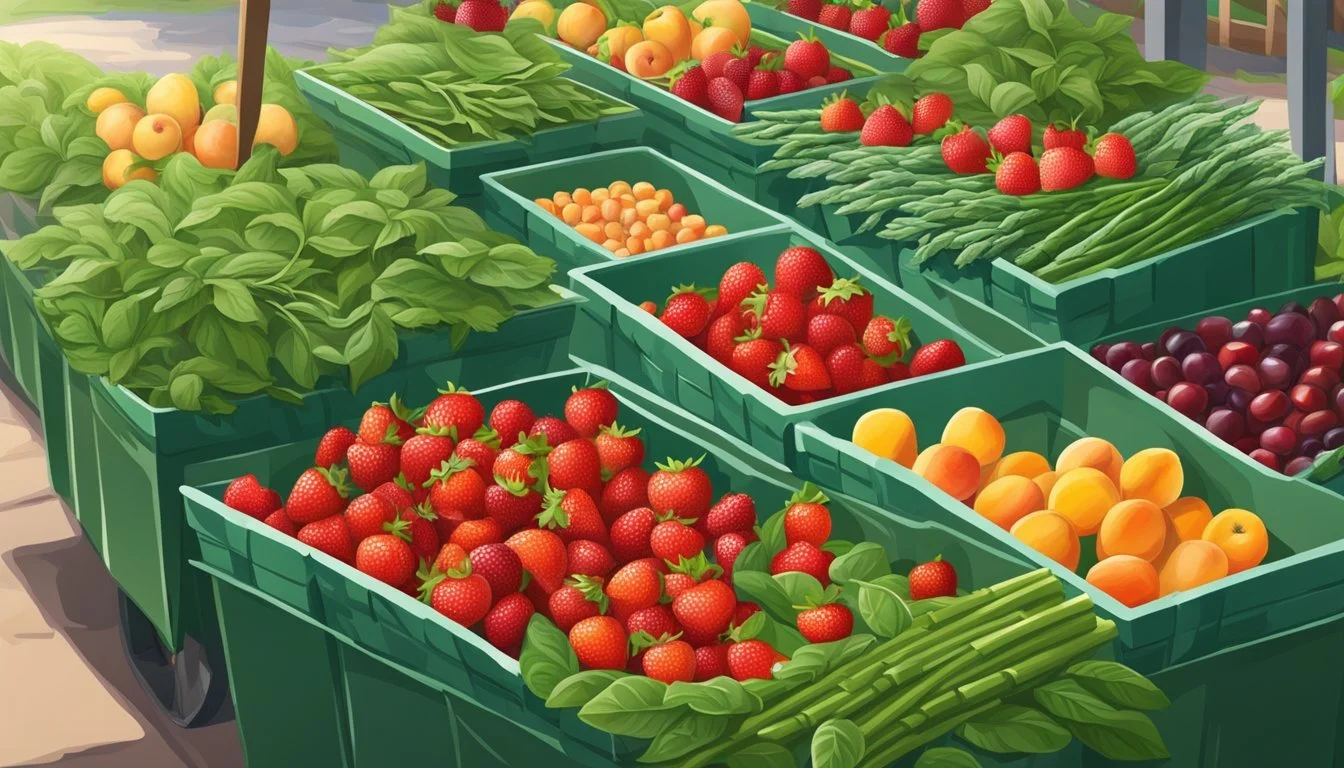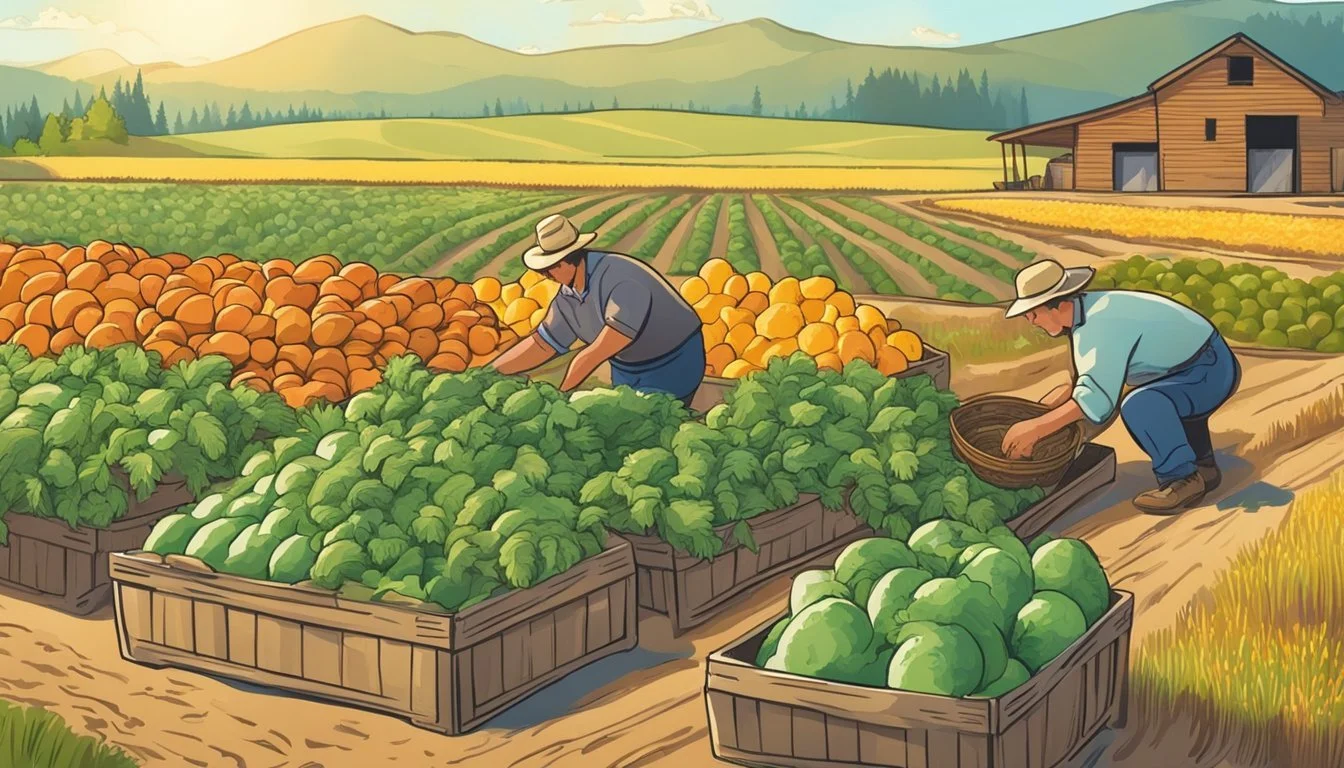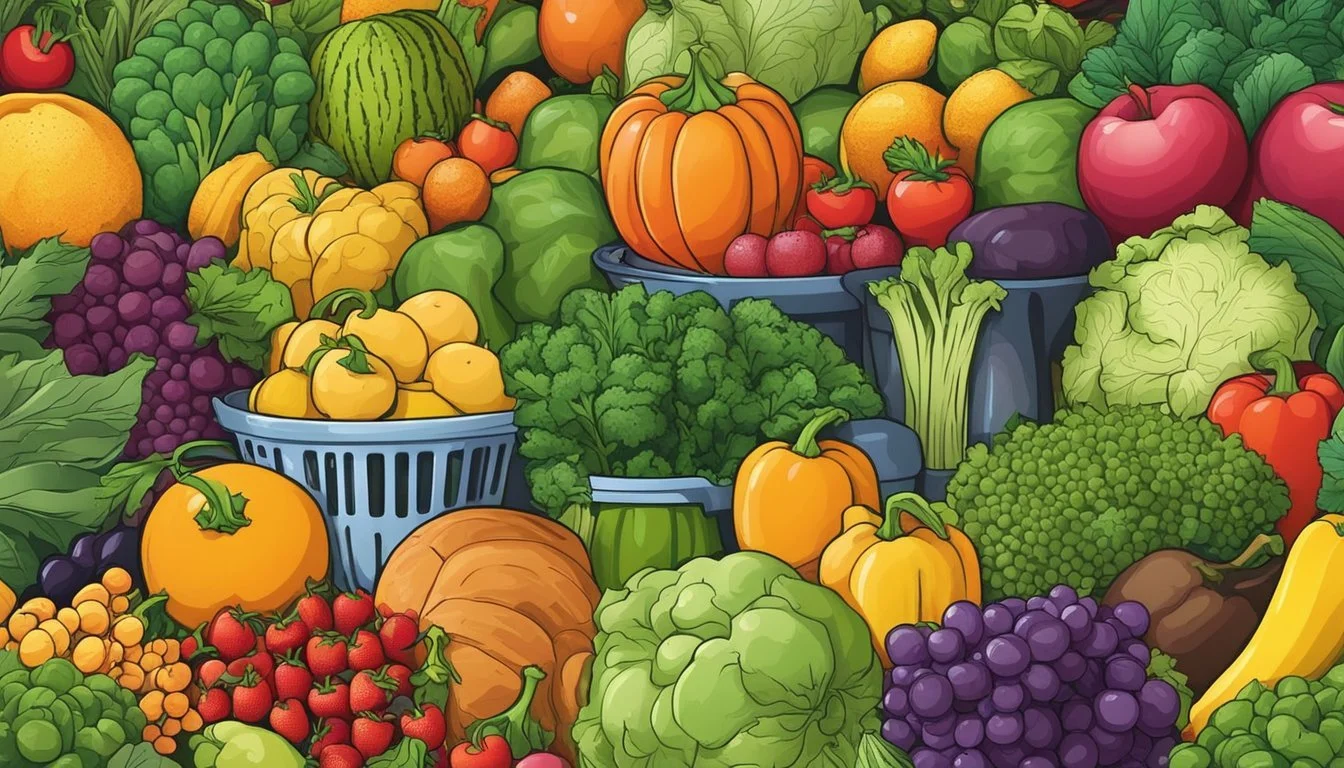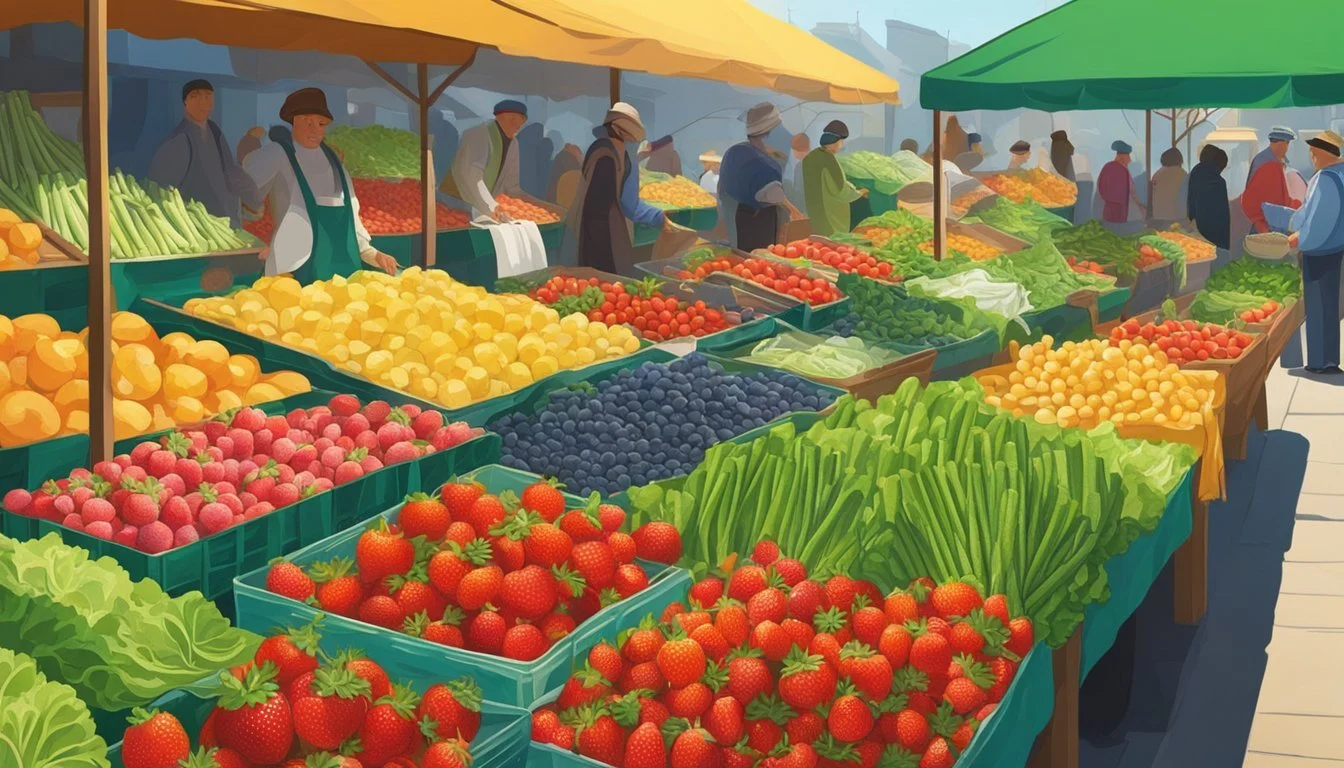Idaho Seasonal Fruit & Vegetables in March
Your Fresh Guide
This Article is Part of our Idaho Seasonal Fruit & Veg Calendar
As the winter season wanes, Idaho's fertile lands begin to yield a variety of fresh produce. March marks a transitional period in the region's agricultural calendar, where the last of winter's offerings intersect with the first signs of spring. This is a time when consumers can enjoy the lingering root vegetables from colder months as well as anticipate the arrival of early spring produce. The climate of Idaho, with its cold winters and warm summers, heavily influences the seasonal availability of fruits and vegetables.
For those interested in consuming fresh, locally grown food, March provides an opportunity to savor the hearty flavors of the season while preparing for the lighter, crisper tastes that lie ahead. Seasonal produce during this month includes the tail end of winter staples such as potatoes and various root vegetables, alongside the fresh greens that signal the coming of spring. It's a month where the bounty of Idaho is on the cusp of change, with farmers and growers preparing for the abundance of growth that spring will bring.
Access to fresh produce is facilitated by Idaho's network of farmers' markets, community supported agriculture (CSA) programs, and local farm stands. These outlets bridge the gap between Idaho's agricultural heritage and the tables of residents and visitors alike, ensuring that the seasonal march of produce finds its way into homes and meals across the state. By integrating these fresh, seasonal offerings into their diets, consumers can enjoy the peak of flavor and nutrition that comes from fruits and vegetables harvested at their best.
Overview of Idaho's Seasonal Produce Calendar
Idaho boasts a wide array of fresh produce that varies with the seasons. In March, the state transitions from winter to spring, bringing changes to the local harvest.
In March, residents and visitors of Idaho find the remaining winter produce as well as the early signs of spring harvest. The weather starts to soften, allowing for the first planting of some cold weather crops.
The seasonal produce calendar for Idaho highlights a variety of in-season produce that can be enjoyed at their peak of freshness. It functions as a guide for consumers looking to source local fruits and vegetables.
Here is a list of typical in-season produce one can find in Idaho during March:
Vegetables:
Spinach (What wine goes well with spinach?)
Winter Squash
Potatoes
Fruits:
Apples (from storage)
While the selection may seem limited due to the cold climate, these items are known for their quality and flavor. The majority of winter squash and potatoes are often available from storage in excellent condition, while crops like spinach and radishes start becoming available as the ground thaws.
It's important for users to consult the latest seasonal produce calendar as there may be variations each year affected by local climate conditions. This ensures access to fresh, flavorful, and nutrient-dense produce from Idaho farms.
Key Vegetables in March
In March, Idaho's chill begins to thaw, yielding a variety of vegetables. Chefs and home cooks favor these for their robust flavors and versatility in everything from raw salads to hearty stews.
Leafy Greens and Cruciferous Vegetables
Idaho sees an abundance of leafy greens such as kale, spinach, and arugula (how long does arugula last?) during March. These greens are perfect for salads and can also be steamed or incorporated into side dishes. Cruciferous vegetables like broccoli (how long does broccoli last?), cabbage, and Brussels sprouts (how long do brussels sprouts last?)are also in season, providing options for both raw and cooked preparations.
Root Vegetables and Tubers
Root vegetables are particularly hearty and suitable for a range of dishes. Crucial for the month of March are carrots and radishes, both excellent whether consumed raw or added to a roast. Potatoes and parsnips remain ever-popular choices for roasting or boiling, often featuring as comforting side dishes.
Alliums and Aromatics
Alliums, with their signature flavors, are prominent in March. Leeks, garlic, and onions become available, instantly elevating dishes with their aromatic qualities. These alliums offer depth to soups, stews, and are indispensable in a variety of cuisines.
Legumes and Podded Vegetables
Legumes start to make their appearance with peas and snap peas becoming ready to harvest. They add a fresh, sweet taste to meals and are often enjoyed steamed or tossed into salads. Beans can be found as well, versatile for both raw and cooked applications, from crunchy snacks to main courses.
Prime Fruits to Enjoy in March
In March, Idaho offers a variety of prime fruits that are at their peak, carrying a blend of sweet and tangy flavors, and are packed with essential vitamins like vitamin C. These prime selections are perfect for enjoying fresh or incorporating into a range of dishes.
Citrus Fruits
Citrus fruits are at their juiciest during March, and they are rich sources of vitamin C.
Oranges: They are especially sweet and perfect for a fresh snack or juicing.
Lemons: Ideal for adding a tangy twist to drinks and recipes.
Tropical Variations
Tropical fruits available in March bring a taste of exotic warmth to the still-cool weather.
Kiwi: An excellent choice to add to salads or smoothies, kiwi is bursting with vitamin C and vitamin K.
Pineapples: These are both sweet and tart, complementing desserts and savory dishes alike.
Hardy Winter Fruits
Even as spring approaches, some winter fruits remain ripe and enjoyable.
Apples: Selections such as Fuji or Granny Smith maintain their crisp texture and sweet flavor.
Pears: Offer a soft and juicy option, with a subtly sweet profile perfect for raw snacking or cooking.
Harvesting and Selecting Quality Produce
March in Idaho heralds the transition from winter’s rest to the budding of spring’s first wave of produce. Consumers invested in the freshness and nutritional content of their fruits and vegetables have a variety of options to choose from during this period. It is pivotal to understand the indicators of quality when selecting seasonal items to ensure peak flavor and nutrients.
Root Vegetables: Staples like parsnips and turnips remain in season. One should look for firm roots, as softness can indicate spoilage. The outer skin should be smooth and free of deep cuts or blemishes.
Greens: Spinach and Swiss chard are lush during this time. Leaves should appear vibrant and un-wilted, showcasing their freshness. A bright color is often correlated with a high density of vitamins and minerals.
Storage Tips:
Root vegetables are best kept in a cool, dark, and well-ventilated space to maintain freshness.
Greens benefit from refrigeration, preferably in a crisper drawer to retain moisture and prevent wilting.
When harvesting produce, timing is critical. Farmers carefully monitor the maturation of crops to capture the precise moment when flavor and nutritional value are at their apex. The delicate balance of Idaho’s climate contributes to the success of these crops.
Consumers are encouraged to engage with local farmers or providers, as they can offer valuable insights into the selections available. They play a pivotal role in ensuring the produce is picked at the right moment and transported with care. By choosing seasonal produce, individuals support sustainable practices and local economies, while enjoying the rich flavors and nutritional benefits that come with eating fresh, seasonal foods.
Storage Tips for March Produce
When handling March produce in Idaho, proper storage is crucial for maintaining freshness and flavor. Here's how to best store some typical vegetables and fruits available during this month.
Vegetables:
Leafy greens like spinach and arugula should be stored in the refrigerator, in a loose plastic bag with a paper towel to absorb excess moisture. They typically last up to a week.
Root vegetables, such as radishes and turnips, are best kept in a cool, dark place, like a cellar or a pantry. They can also be refrigerated for extended freshness.
For potatoes, store them in a cool, dark, and well-ventilated place to prevent sprouting. Avoid refrigeration as cold temperatures can convert starches into sugar.
Fruits:
Citrus fruits should be stored on a countertop at room temperature away from direct sunlight, or they can be refrigerated to extend their shelf life.
Berries have a short shelf life and should be kept in their original container in the refrigerator. They should be washed just before eating, not before storing.
Here is a quick reference table for some common March produce in Idaho:
Produce Storage Location Expected Shelf Life Spinach Refrigerator Up to 1 week Arugula Refrigerator Up to 1 week Radishes Cool, dark place 1-2 weeks Turnips Cool, dark place 1-2 weeks Potatoes Cool, dark place Several weeks Citrus fruits Countertop/fridge 1-3 weeks Berries Refrigerator 2-3 days
It's recommended that most fruits and vegetables are kept separate to prevent the faster-ripening fruits from hastening the spoilage of other items. Always inspect produce for signs of spoilage such as mold or off smells before storage.
Preparation Techniques for March Produce
March offers a bounty of fresh produce that can transform into a variety of dishes from crisp salads to hearty meals. Whether one is blanching vegetables for a bright side dish or incorporating fruits into fresh salads, the rich flavors of March's produce are versatile in the kitchen.
Salad Creations
When crafting salad bowls, using fresh greens such as spinach is key. They offer a nutritional foundation that pairs well with a variety of March fruits and vegetables.
Dressing: For a simple, homemade dressing, mix olive oil, lemon juice, salt, and pepper. This dressing enhances the natural flavors of the produce.
Fruit Add-ins: Consider adding slices of fresh pineapple for a sweet burst of flavor.
Vegetable Toppings: Radishes sliced thinly provide a peppery crunch while blanched asparagus(how long does asparagus last?) contributes a tender bite to the salad.
Cooking Variations
Cooking March produce can involve several techniques to enhance their natural flavors.
Steam: Vegetables like broccoli retain maximum nutrition and vibrant color.
Grill: Vegetables with natural sugars, like asparagus, caramelize and develop a subtle smokiness when grilled.
Roast: Try roasting root vegetables such as turnips or sweet potatoes to bring out a deeper sweetness.
Hearty Meals and Sides
March vegetables can be the star of a meal or serve as delightful companions to main dishes.
Casseroles: Incorporate blanched spinach or Swiss chard into creamy casseroles for added texture and a nutritional boost.
Side Dish: Roasting a medley of March vegetables with herbs makes for an aromatic side that complements proteins like chicken.
Pasta (how long does pasta last?): Toss steamed broccoli with pasta, olive oil, and garlic for a quick and nourishing meal.
Nutrition and Health Benefits
In March, Idaho's seasonal fruits and vegetables provide a wealth of nutritional and health benefits. The consumption of these fresh produce items can significantly contribute to an individual's intake of essential nutrients and vitamin C.
Fruits:
Raspberries: They are rich in dietary fiber, antioxidants, and packed with vitamin C. The consumption of raspberries can aid in maintaining a healthy immune system and contribute to skin health.
Watermelon: It is a hydrating fruit that's a good source of vitamin C and also provides a refreshing taste with low calories, supporting hydration and nutrition.
Vegetables:
Spinach: This leafy green is high in vitamin K and folate, with a substantial amount of vitamin C. Spinach supports bone health and immune function.
Rutabagas: Offering a good mix of fiber and vitamin C, rutabagas can boost immunity and aid digestive health.
Sweet Potatoes and Yams: These root vegetables are not only high in vitamin C but also beta-carotene and fiber, promoting eye health and immune function.
Eating these seasonal products at their peak can offer optimal taste and nutritional benefits, including a higher content of vitamin C, which is crucial for immune defense and skin health.
Produce Item Notable Nutrients Health Benefits Raspberries Vitamin C, Fiber Immune support, Skin health Watermelon Vitamin C, Hydration Hydration, Nutritional refreshment Spinach Vitamin K, Vitamin C Bone health, Immune function Rutabagas Fiber, Vitamin C Immune boost, Digestive health Sweet Potatoes Vitamin C, Beta-carotene Eye health, Immune system support
By including these fruits and vegetables in their diet, individuals may enjoy the nutritional advantages that these seasonal Idaho offerings afford.
Idaho Seasonal Recipes
March in Idaho boasts a variety of seasonal produce that can inspire numerous recipes, from hearty salads to robust roasts. Utilizing local and in-season fruits and vegetables not only supports Idaho's farming community but also ensures that meals are enriched with the freshest flavors.
Salads: One can start with a simple yet satisfying salad. Utilizing crisp, fresh greens such as spinach or kale, which are plentiful during this time, makes for a great base. Accents of roasted beets or carrots can add both a touch of warmth and sweetness. Tossing these ingredients with a homemade dressing can elevate the dish, perhaps incorporating locally produced honey or herbs for an Idaho twist.
Roasts: As the winter lingers, a comforting roast is appropriate. Foods like winter squash or potatoes, readily available in March, can be roasted to perfection to accompany a main dish. Seasoning with rosemary, garlic, or chives, which may also be in season, enhances the earthiness of these vegetables.
Pasta Dishes: For a heartier meal, pasta dishes that incorporate seasonal vegetables such as garlic and onions provide richness and depth. One might create a sauce from scratch using pureed winter squash, or fold roasted vegetables into a warm pasta salad.
Cookbook Inspirations: For those seeking specific Idaho-inspired recipes, local cookbooks may contain a treasure trove of ideas. These recipes often highlight the best ways to utilize the seasonal produce in cooking various dishes, ensuring that the local palate is catered to.
Incorporating the flavors of Idaho’s March offerings into meals is a splendid way to celebrate the region's culinary abundance. Chefs, home cooks, and food enthusiasts alike can take pride in creating dishes that reflect the seasonal availability of high-quality local produce.
Conclusion
In March, Idaho's seasonal produce selection begins to transition. The state's markets start to showcase early spring crops, though the variety may still be limited compared to summer months. Consumers can expect to find an array of hearty vegetables and a hint of early spring freshness in their local Idaho produce aisles.
Vegetables in Season:
Asparagus
Beetroot
Brussels sprouts
These vegetables not only offer robust flavors but also contain essential nutrients beneficial for maintaining health during the changing seasons. They represent Idaho's agricultural resilience and the state's capability to grow a range of produce despite the tail end of winter conditions.
Planning: Those planning their meals or seeking to incorporate fresh, local ingredients into their diet should consider these seasonal offerings. March may not bring the full abundance of summer, but it provides a unique opportunity to enjoy the early sprouts of spring.
By choosing Idaho's seasonal produce in March, one supports local farmers and the regional economy, while also benefiting from the nutritional peak of these crops. The produce is fresher, often tastes better, and may even cost less due to reduced transport needs.
In summary, the month of March invites consumers to explore and enjoy the transitioning bounty of Idaho's agriculture. It's a month to celebrate the last of the winter's yield and look forward to the promise of spring's abundance.










